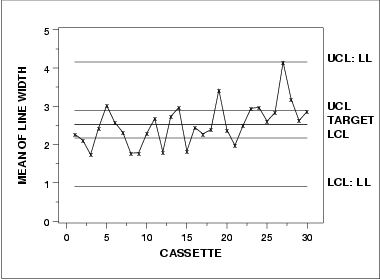6.
Process or Product Monitoring and Control
6.6.
Case Studies in Process Monitoring
6.6.1.
Lithography Process
6.6.1.4.
|
Shewhart Control Chart
|
|
|
Choosing the right control charts to monitor the process
|
The largest source of variation in this data is the lot-to-lot
variation. So, using classical Shewhart methods, if we specify our
subgroup to be anything other than lot, we will be ignoring the
known lot-to-lot variation and could get out-of-control points that
already have a known, assignable cause - the data comes from
different lots. However, in the lithography processing area the
measurements of most interest are the site level measurements, not
the lot means. How can we get around this seeming contradiction?
|
|
Chart sources of variation separately
|
One solution is to chart the important sources of variation
separately. We would then be able to monitor the variation of
our process and truly understand where the variation is coming
from and if it changes. For this dataset, this approach would
require having two sets of control charts, one for the individual
site measurements and the other for the lot means. This would
double the number of charts necessary for this process (we would
have 4 charts for line width instead of 2).
|
|
Chart only most important source of variation
|
Another solution would be to have one chart on the largest source
of variation. This would mean we would have one set of charts that
monitor the lot-to-lot variation. From a manufacturing standpoint,
this would be unacceptable.
|
|
Use boxplot type chart
|
We could create a non-standard chart that would plot all the
individual data values and group them together in a
boxplot type format by
lot. The control limits could be generated to monitor the
individual data values while the lot-to-lot variation would be
monitored by the patterns of the groupings. This would take
special programming and management intervention to implement
non-standard charts in most floor shop control systems.
|
|
Alternate form for mean control chart
|
A commonly applied solution is the first option; have multiple
charts on this process. When creating the control limits for the
lot means, care must be taken to use the lot-to-lot variation
instead of the within lot variation. The resulting control charts
are: the standard individuals/moving range charts (as seen
previously), and a control chart on the lot means that is
different from the previous lot means chart. This new chart uses
the lot-to-lot variation to calculate control limits instead of
the average within-lot standard deviation. The accompanying
standard deviation chart is the same as seen previously.
|
|
Mean control chart using lot-to-lot
variation
|

The control limits labeled with "UCL" and "LCL" are the
standard control limits. The control limits labeled with
"UCL: LL" and "LCL: LL" are based on the lot-to-lot variation.
|


